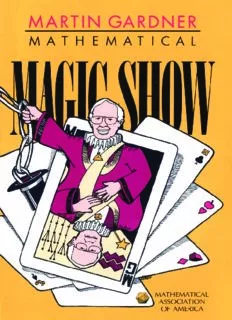
Mathematical Magic Show: More Puzzles, Games, Diversions, Illusions and Other Mathematical Sleight-Of-Mind from Scientific American PDF
Preview Mathematical Magic Show: More Puzzles, Games, Diversions, Illusions and Other Mathematical Sleight-Of-Mind from Scientific American
Mathematical Magic Show M A R T I N G A R D N E R THE MATHEMATICAL ASSOCIATION OF AMERICA Washington, D. C. 1989 More Puzzles, Games, Diversions, Illusions and Other Mathematical Sleight-of-Mind from Scientific American with a Foreword by Persi Diaconis and Ronald 1. Graham, Afterthoughts from the Author, a new Postscript, and a new Bibliography by Mr. Gardner, Repartee from Readers, and 139 Drawings and Diagrams. The following works by M. C. Escher appear in Mathematical Magic Show. They are used with the permission of the M. C. Escher Company. All of these works 02007 The M. C. Escher Company -Holland. All rights reserved. www.mcescher.com. 10. Mobius Strip I, a 1961 engraving 11. Mobius Strip 11, a woodcut Published in the United States of America by The Mathematical Association of America Copyright O 1965,1967,1968,1976,1977 and 1990 by Martin Gardner. All rights reserved under International and Pan-American Copyright Conventions. An MAA Spectrum book This book was updated and revised from the 1977 edition published by Alfred A. Knopf, Inc., New York. The excerpt from Night Thoughts by Edmund Wilson is reprinted with the permission of Farrar, Straus & Giroux, Inc. Copyright 1953,O 1961 by Edmund Wilson. Library of Congress Catalog Card Number 89-064- 116 ISBN 0-88385 Manufactured in the United States of America Cover and title page cartoons by John Johnson For Jim and Amy Contents Introduction 1. Nothing 2. More Ado About Nothing 3. Game Theory, Guess It, Foxholes Answers on page 48 4. Factorial Oddities Answers on page 63 5. The Cocktail Cherry and Other Problems Answers on page 73 6. Double Acrostics Answers on page 92 7. Playing Cards Answers on page 103 8. Finger Arithmetic Answers on page 122 9. Mobius Bands Answers on page 136 10. Ridiculous Questions Answers on page 142 Polyhexes and Polyaboloes Answers on page 157 Perfect, Amicable, Sociable Answers on page 170 Polyominoes and Rectification Answers on page 185 Knights of the Square Table Answers on page 202 The Dragon Curve and Other Problems Answers on page 210 Colored Triangles and Cubes Answers on page 237 Trees Answers on page 249 Dice Answers on page 261 Everything Postscript Bibliography Foreword MANYRE ADERS may not know the many dimensions of Martin Gardner's magic. To begin with, he is a superb sleight-of-hand art- ist and the inventor of hundreds of magic tricks. His earliest pub- lished pieces, written when he was in high school, were contribu- tions to The Sphinx, an American magic periodical. Martin enjoys performing close-up magic for those fortunate enough to know him. He likes to bounce a dinner roll on the floor (it bounces back up like a rubber ball), to swallow a table knife, or to link a bor- rowed finger ring onto a rubber band. He has a special fondness for tricks that seem to violate topological laws. A completely different kind of magic is Martin's ability to ex- plain significant mathematical ideas to laymen, always in a way that leaves them eager for more. Unlike many other popularizers of mathematics, professionals enjoy his writing as much as ama- teurs. When asked how he manages this, he insists that the secret is precisely his lack of advanced knowledge. In college he took not a single matllematics course. It was not until 1989 that he finally coauthored his first formal paper that reported new discoveries. Although self-taught in mathematics, Martin has influenced the lives of manyprofessionals, including both of us. In one case he converted a runaway teen-age magcian into a budding mathema- tician by publishing some of his mathematical magic ideas, and by later helping that same youth find his way into graduate work. In the other case, many fertile research problems have sprung from Martin's efforts to understand certain puzzles in order to create new ones. Martin's success did not come easily. After graduating from the University of Chicago in 1936 with a bachelor's degree in philoso- phy, he began his writing career as a newspaper reporter in Tulsa, and later as a writer in the University of Chicago's press relations office. After four years in the Navy during World War 11, he began selling fiction to Esquire, moved to Manhattan, and became one of the editors of Humpty DumptyS Magazine. After eight years of in- venting bizarre activity features and writing stories and poems for five-t~-eight-~eoalrd readers, he began his celebrated column in Scientific American. Before then, our informants tell us, he lived for years in small, dingy sleeping rooms, wearing frayed collars and pants with holes, often limiting his lunch to coffee and a piece of Danish. Martin put a great deal of research effort into his ScientlficAmer- ican columns. He once told us that writing the column left him only a few working days a month. His main reason for retiring from the magazine was that he needed time to write books and ar- ticles about topics other than mathematics. He is now the author of more than forty volumes that range over such fields as science, phi- losophy, and literature as well as mathematics. His long out-of- print theological novel, The FZght of Peter Fromm was reissued in 1989 by Farrar, Straus, and Giroux. Many of his books are collec- tions of literary essays and book reviews. We visited Martin recently and were struck by the enthusiasm and boyish wonder with which he reacted to a magic sleight per- formed by one of us that he has not seen before-a curious method of false cutting of a deck of cards. At an age past seventy, he is as eager as he was in high school to master what magicians call a new and novel "move." RONALDL . GRAHAM AT&T Bell Laboratories and Rutgers University PERSID IACONIS Harvard University Fall 1989
